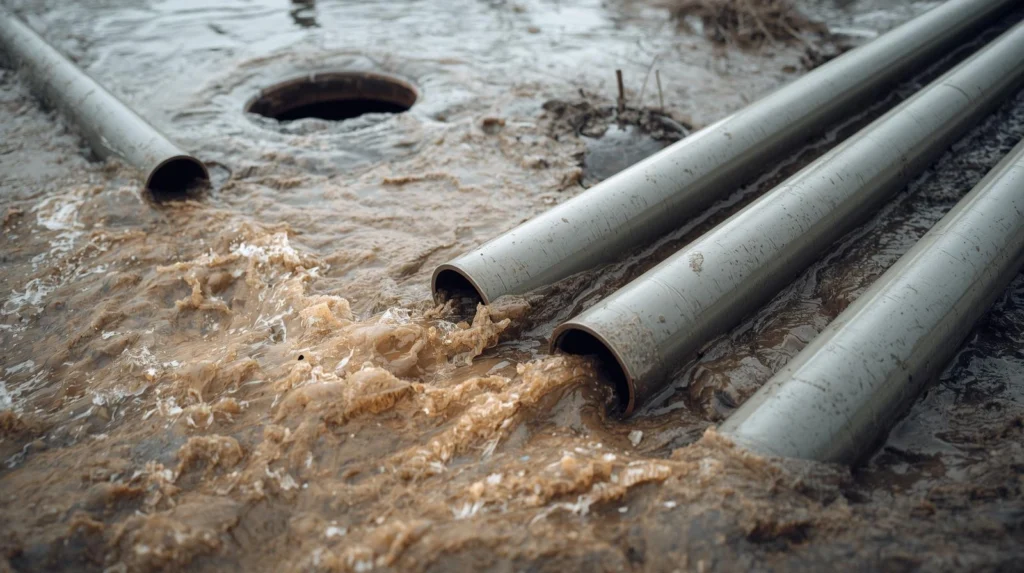Imagine this: a major storm hits a coastal city prone to flooding. Streets are submerged, properties are damaged, and infrastructure is compromised. Yet, amidst the devastation, one part of the infrastructure holds strong – the water distribution system. Why? Because it’s made with HDPE pipes, a revolutionary solution for flood-prone areas.
Flooding poses a significant threat to water infrastructure, often damaging traditional pipe systems. In these conditions, water distribution systems need to be resilient, flexible, and capable of withstanding extreme weather events. High-Density Polyethylene (HDPE) pipes have emerged as the solution. In this post, we’ll explore why HDPE pipes are essential for water distribution in flood-prone areas, highlighting their benefits, applications, and real-world examples.
By the end, you’ll understand how HDPE pipes can safeguard water systems and ensure a reliable supply of clean water, even in the face of rising flood risks.
Why is Resilient Water Distribution So Important?
What are the key challenges in flood-prone areas?
Flood-prone areas face unique challenges when it comes to water distribution systems. Heavy rains, rising water levels, and soil erosion can damage infrastructure, leading to service disruptions. Furthermore, traditional materials like PVC and concrete pipes can crack or collapse when exposed to floodwaters, resulting in costly repairs, contamination, and water shortages.
In flood-prone regions, it’s essential to have a water distribution system that can endure such harsh conditions. This is where HDPE pipes come into play.
How do HDPE pipes solve these challenges?
HDPE pipes are well-suited for flood-prone environments due to their flexibility, strength, and corrosion resistance. Unlike traditional pipes, HDPE pipes can expand and contract without cracking under pressure. Their seamless joints and resistance to water infiltration make them ideal for withstanding flooding and groundwater seepage.
Pro Tip: When dealing with flood-prone areas, always consider HDPE pipes for long-term water distribution solutions. Their resilience can prevent costly damage and provide a more reliable service.
The Unique Benefits of HDPE Pipes in Flood-Prone Areas
What makes HDPE pipes different from traditional materials?
HDPE pipes offer numerous advantages over traditional water distribution materials like PVC, steel, and concrete. These include:
- Flexibility: HDPE pipes can expand and contract, absorbing the pressure caused by soil movement or floodwaters without breaking.
- Corrosion Resistance: HDPE is naturally resistant to corrosion, making it ideal for areas exposed to water and other harsh elements.
- Leak-Free Joints: The fused joints in HDPE piping create a leak-proof system, which is essential for preventing contamination during flooding.
- Long Lifespan: HDPE pipes can last for decades with minimal maintenance, offering a cost-effective solution for water distribution.
Real-World Example: The Importance of HDPE in Pakistan
In flood-prone areas like Pakistan, HDPE pipes are becoming increasingly popular for new water distribution projects. After the catastrophic 2010 floods, authorities began replacing traditional water pipes with HDPE pipes, recognizing their resilience in extreme weather conditions. This shift not only minimized water supply interruptions but also contributed to a more sustainable and reliable infrastructure.
Statistics: According to a study by the Pakistan Water Partnership, HDPE pipes have reduced water leakage by 40% in urban areas prone to flooding, improving both water quality and efficiency.
How do HDPE pipes contribute to reducing water contamination during floods?
Floodwaters are often contaminated with sewage, chemicals, and debris, posing a severe risk to public health. HDPE pipes help minimize this risk due to their leak-proof joints and smooth internal surfaces. This ensures that water stays uncontaminated, even when external pressures like flooding occur.
Applications of HDPE Pipes in Flood-Prone Areas
How are HDPE pipes used in water distribution systems?
HDPE pipes are commonly used for:
- Underground Water Supply: Their flexibility makes them perfect for buried pipelines in flood-prone areas, where soil movement and pressure are concerns.
- Stormwater Drainage: HDPE pipes can be used for draining excess floodwater, preventing damage to surrounding infrastructure.
- Floodwater Mitigation Projects: In flood-prone regions, HDPE pipes are often installed as part of mitigation efforts to direct floodwater away from vital areas.
Case Study: Flood-Proofing New Orleans’ Water Supply System
After the catastrophic flooding caused by Hurricane Katrina in 2005, New Orleans began investing in more resilient water systems. HDPE pipes were chosen for their ability to withstand water pressure and resist cracking. As part of the city’s water infrastructure recovery, HDPE pipes were installed to replace older, more vulnerable systems. This has significantly improved the city’s resilience to future flooding, ensuring that clean water continues to flow despite extreme weather.
Pro Tip: In urban planning, consider HDPE pipes not just for water distribution but for floodwater management as well. Their versatility makes them essential in comprehensive flood-proofing strategies.
Cost-Effectiveness of HDPE Pipes in Flood Zones
Are HDPE pipes more affordable than traditional alternatives?
At first glance, HDPE pipes may seem more expensive than traditional options like PVC. However, when considering their durability, ease of installation, and low maintenance costs, HDPE pipes provide long-term savings. In flood-prone areas, the ability to avoid costly repairs and replacements after a flood can make HDPE pipes a more cost-effective solution in the long run.
Pro Tip: While the initial installation cost may be higher, HDPE pipes’ longer lifespan and reduced maintenance requirements often result in a lower total cost of ownership.
Environmental Benefits of HDPE Pipes
How do HDPE pipes contribute to sustainable water management?
HDPE pipes are environmentally friendly in several ways:
- Recyclable: HDPE is a recyclable material, reducing environmental waste.
- Minimal Energy Use: The manufacturing process for HDPE pipes uses less energy compared to other materials, reducing the carbon footprint.
- Leak Prevention: By preventing water loss and contamination, HDPE pipes help conserve water, a precious resource in flood-prone areas.
Conclusion
HDPE pipes offer an essential solution for water distribution systems in flood-prone areas. Their flexibility, durability, and resistance to flooding make them the ideal choice for ensuring reliable water delivery in challenging environments. By using HDPE pipes, communities can mitigate the risks associated with flooding, reduce contamination, and build sustainable, resilient infrastructure that stands the test of time.
If you’re involved in water infrastructure planning or development, make sure to incorporate HDPE pipes in your projects. Not only will they help reduce costs and improve system longevity, but they will also protect communities from the devastating effects of floods.
Call to Action:
Looking to learn more about HDPE pipes for your next project? Contact us today for expert consultation on how to integrate HDPE pipes into your flood-resistant water distribution system!
High-Quality Pipes & Fittings – Built to Last
FAQ Section
1. Why should I choose HDPE pipes over PVC for flood-prone areas?
HDPE pipes offer superior flexibility and resistance to cracking, making them a better choice for flood-prone areas where soil movement and water pressure are significant concerns.
2. How long do HDPE pipes last in flood-prone areas?
HDPE pipes can last up to 50 years or more with minimal maintenance, making them a long-term solution for water distribution in challenging environments.
3. Can HDPE pipes be used for both water supply and drainage systems?
Yes, HDPE pipes are versatile and can be used for both water supply and stormwater drainage systems in flood-prone areas.
4. How do HDPE pipes help reduce water contamination during floods?
The leak-proof joints and smooth internal surfaces of HDPE pipes prevent water from being contaminated by floodwater, ensuring safe and clean drinking water.
5. Are HDPE pipes more expensive than other types of pipes?
While the initial installation cost of HDPE pipes may be higher than traditional options like PVC, their durability and low maintenance costs make them more cost-effective in the long run.
6. Can HDPE pipes be used in emergency floodwater mitigation projects?
Yes, HDPE pipes are ideal for emergency floodwater mitigation, as they can be quickly installed to direct floodwater away from critical areas.
7. What are the environmental benefits of using HDPE pipes?
HDPE pipes are recyclable, energy-efficient to manufacture, and help conserve water by preventing leaks, making them an environmentally friendly option for water distribution systems.


